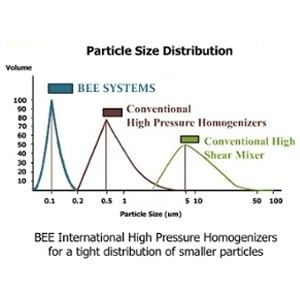
A variety of industries – such as chemical, pharmaceutical, biotech, cosmetic, food, and others – rely on particle size reduction in their manufacturing processes. As one might expect, there are several particle size reduction equipment options available.
In this article, we highlight some key factors to consider when choosing the right particle size reduction equipment:
1. Material Properties
In choosing the right equipment, manufacturers need to know the properties of the materials that they wish to process. These properties include, but are not limited to:
- The hardness of the resulting new surface area.
- The toughness or weakness of the material (the weaker the material, the more brittle it is and therefore the more likely it can fracture during the particle size reduction process).
- The bulk density.
- The level of abrasiveness.
- The amount of moisture content.
- The level of toxicity.
- The temperature sensitivity.
2. The Desired Particle Size Distribution
Manufacturers must also take into consideration the desired particle size distribution, since this is essential to the integrity or efficacy of the end product. The optimal distribution is often expressed via the Gaudin-Schuhmann equation, which is derived from the fact that softer materials produce more fines.
3. Whether it is Necessary or Desirable to Proceed in Stages
It is sometimes necessary or desirable for manufacturers to perform particle size reduction in a series of stages vs. a one-time process, since it can be more efficient (the exception would be if the manufacturer desires to produce extremely fine particles). As such, the right equipment would need to support this stage-by-stage particle size reduction approach and ensure that it was efficient and viable.
Pion's Property Technology
At Pion, our proprietary equipment is designed specifically to break particles apart and achieve consistent, controlled particle size reduction for a variety of applications.
Unlike other equipment that applies only one mechanical force to mix a product, our equipment uses all mechanical forces to achieve optimum results, including: turbulence, cavitation, shear, and impact.
Furthermore, the process intensity can be easily adjusted with the turn of a dial from 2,000 - 45,000 psi/150 - 3100 bar, and the mixing forces noted above can be precisely calibrated to produce optimal results for a specific product. For example, turbulent premixing can be replaced with a laminar flow, cavitation can be intensified or reduced by adjusting nozzle size, shear process time can be longer or shorter, impact can be maximized (via reverse flow setup).
Learn more about our groundbreaking equipment here.

